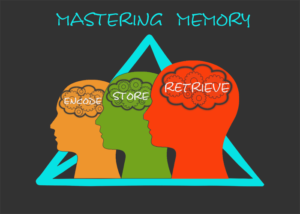6.2: Master Your Memory
- Page ID
- 71143
\( \newcommand{\vecs}[1]{\overset { \scriptstyle \rightharpoonup} {\mathbf{#1}} } \) \( \newcommand{\vecd}[1]{\overset{-\!-\!\rightharpoonup}{\vphantom{a}\smash {#1}}} \)\(\newcommand{\id}{\mathrm{id}}\) \( \newcommand{\Span}{\mathrm{span}}\) \( \newcommand{\kernel}{\mathrm{null}\,}\) \( \newcommand{\range}{\mathrm{range}\,}\) \( \newcommand{\RealPart}{\mathrm{Re}}\) \( \newcommand{\ImaginaryPart}{\mathrm{Im}}\) \( \newcommand{\Argument}{\mathrm{Arg}}\) \( \newcommand{\norm}[1]{\| #1 \|}\) \( \newcommand{\inner}[2]{\langle #1, #2 \rangle}\) \( \newcommand{\Span}{\mathrm{span}}\) \(\newcommand{\id}{\mathrm{id}}\) \( \newcommand{\Span}{\mathrm{span}}\) \( \newcommand{\kernel}{\mathrm{null}\,}\) \( \newcommand{\range}{\mathrm{range}\,}\) \( \newcommand{\RealPart}{\mathrm{Re}}\) \( \newcommand{\ImaginaryPart}{\mathrm{Im}}\) \( \newcommand{\Argument}{\mathrm{Arg}}\) \( \newcommand{\norm}[1]{\| #1 \|}\) \( \newcommand{\inner}[2]{\langle #1, #2 \rangle}\) \( \newcommand{\Span}{\mathrm{span}}\)\(\newcommand{\AA}{\unicode[.8,0]{x212B}}\)

| Type | Sample Method |
| Acronyms | Every discipline has its own language and acronyms are the abbreviations. Acronyms can be used to remember words in sequence or a group of words representing things or concepts. CAD can mean: Control Alt Delete, Canadian Dollar, Computer Aided Design, Coronary Artery Disease, Canadian Association of the Deaf, Crank Angle Degree, etc. |
| Acrostics | Acrostics are phrases where the first letter of each word represents another word. They are relatively easy to make and can be very useful for remembering groups of words. For example: King Philip Can Only Find His Green Slippers. This is the classification system of: Kingdom, Phylum, Class, Order, Family, Genus, Species. |
| Chunking | You can capitalize on your short term memory by “chunking” information. If you need to remember this number: 178206781. The task would exhaust your seven units of storage space unless you “chunk” the digits into groups. In this case, you could divide it into three chunks, like a social insurance number: 178 206 781. By chunking the information and repeating it you can stretch the capacity of your short term memory. |
| Images | This helps us remember by linking words to meanings through associations based on how a word sounds and creating imagery for specific words. This sort of visualization was found to be more effective when one listened to a someone reading a text than when they read the text themselves |
| Locations and Journeys | Traditionally known as the Method of Loci, we associate each word from a list or grouping with a location. Imagine a place with which you are familiar, such as, the rooms in your house. These become the objects of information you need to memorize. Another example is to use the route to your work or school, with landmarks along the way becoming the information you need to memorize. When you do this in order of your journey through the imagined space, it makes it easier to retrieve all of the information in the future. |
| Maps & Diagrams | Graphic organizers help us remember by connecting new information to our existing knowledge and to let us see how concepts relate to each other and fit in to a context. Mind and concept maps, Cause and Effect, Fishbone, Cycle, Flow Chart, Ladders, Story Board, Compare and Contrast, Venn Diagrams, and more. |
| Reciting | Saying something out loud activates more areas of our brain and helps to connect information to other activities. |
| Rhymes | Rhyme, rhythm, repetition, and melody make use of our brain’s ability to encode audio information and use patterns to aid memory. They help recall by limiting the possible options to those items that fit the pattern you have created. |
| Summarizing | This traditional element of note taking is a way to physically encode materials which make it easier for our brain to store and retrieve. I can be said that if we cannot summarize, then we have not learned…yet. |
Try It:
- Dubuc, B. (2002). Memory and learning. Retrieved from http://thebrain.mcgill.ca/flash/a/a_07/a_07_p/a_07_p_tra/a_07_p_tra.html↵
- MindTools Content Team. (n.d.). Introduction to memory techniques. Retrieved from https://www.mindtools.com/memory.html↵
- Whitehead, J., Fraenkel, C., Yu, E., & Van Der Mark, A. (2017, February 1). Memory. Retrieved from http://etec.ctlt.ubc.ca/510wiki/index.php?title=Memory&oldid=63689↵

